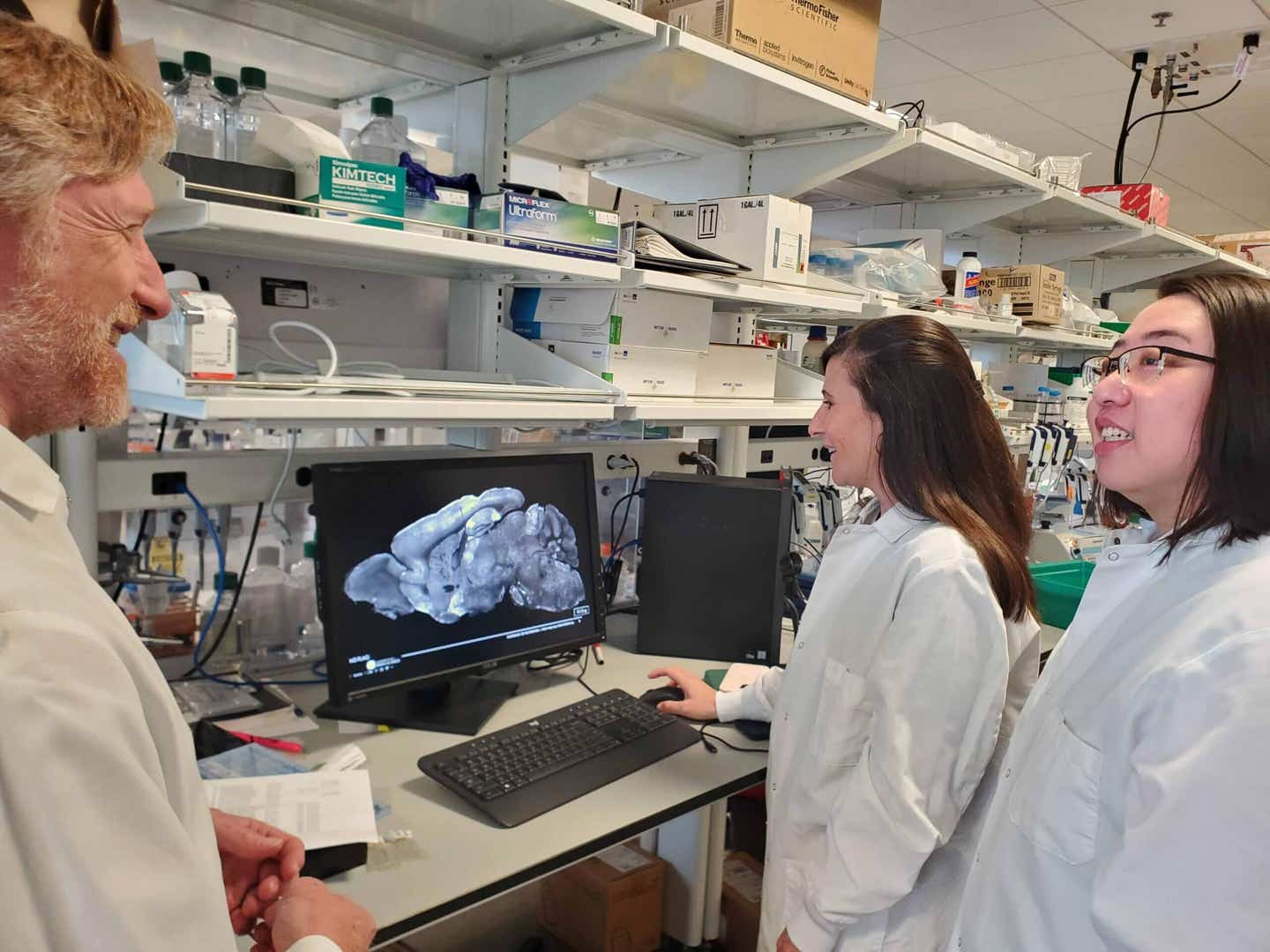New gene therapy fixes brain disorders related to autism and epilepsy
Gene therapy reversed seizures and behavioral symptoms in mice with SYNGAP1 disorders, offering hope for human treatment.

Scientists used a viral gene therapy to restore brain function in mice with SYNGAP1-related disorders, reducing seizures and behavioral symptoms. (CREDIT: Allen Institute)
A new study has brought scientists one step further in the direction of developing a cure for a brutal group of rare brain disorders known as SYNGAP1-related disorders, or SRDs. Researchers were able to successfully use a gene therapy technique to insert a working version of the human SYNGAP1 gene into the brain cells of mice.
Not only did the treatment reduce seizures, but also improved behavior and brain function—new hope for families suffering from these disorders.
What Makes SYNGAP1 Disorders So Hard
SYNGAP1 disorders occur when there is a deficiency of one of the two copies of the SYNGAP1 gene. This deficiency of the SynGAP protein upsets the manner in which neurons communicate with one another, leading to epilepsy, learning disabilities, movement disorders, and autism-like symptoms. Cures today only treat symptoms, such as seizures, without addressing the genetic defect.
Reinserting or introducing the faulty gene would correct the root cause. The SYNGAP1 gene is large, though, and does not easily accommodate standard gene delivery systems. That has been one of the chief challenges to gene therapy for SRDs until now.
Building a "Delivery Truck" for the Gene
The researchers, spearheaded by researchers at the Allen Institute, were able to overcome this hurdle through the help of a harmless virus called an adeno-associated virus, or AAV. The viruses act as delivery vehicles that transport genetic "cargo" into brain cells. Researchers were able to stuff the entire human SYNGAP1 gene into an AAV—something that had been deemed impossible before.
Once packaged, the virus was engineered to activate the gene in neurons throughout the brain. When the researchers administered the therapy to infant mice that had been genetically engineered to have a single copy of functional SYNGAP1, the results were dramatic.
In the untreated mice, brain recordings showed bursts of chaotic electrical activity—types that are characteristic of epilepsy. In the gene therapy-treated mice, those abnormal spikes in the brain all but disappeared. Seizures were much less frequent, and brain wave activity overall returned to more normal levels.
These impacts weren't short-lived. Months following treatment, the treated mice still were able to sustain strong, long-term reductions in epileptic activity, so the effects of the therapy could be long-lasting.
Behavioral and Cognitive Improvements
Senior author Dr. Boaz Levi of the Allen Institute stated that the finding is a significant breakthrough. "Gene supplementation is providing a healthy new copy of an ill gene, a process that has great promise for fixing diseases in which a gene is entirely absent or one copy of a gene is lost," Levi said. This provides a definitive evidence that SYNGAP1-related disorders may be managed through the application of a neuron-specific gene supplementation strategy."
Apart from how it impacts seizures, the therapy caused noticeable changes in the mice's behavior. SYNGAP1-deficient mice, if left untreated, are usually impulsive, hyperactive, and willing to take unusual risks. The mice, though, became less rambunctious and behaved normally once treated. They performed better in memory and exploration tasks with increased attention and learning effects.
The therapy also improved brain rhythms involved in memory and attention—a pivotal step, since abnormally acting brain waves are highly correlated with cognitive deficits in human SRD patients.
Timing Is Everything
One of the most encouraging findings was when the treatment worked best. The researchers treated the mice during the juvenile stage, similar to early childhood in humans—the same age children with SRDs are usually diagnosed. Even though symptoms had already begun to appear, treatment at this age still restored brain and behavioral function.
This timing discovery reveals that the therapy could be beneficial for symptomatic children already, rather than requiring treatment before birth or early in childhood. Although treatment early in life could have even broader benefits, this discovery proves it's never too late when symptoms do occur.
To confirm the new gene was functioning normally, researchers checked brain tissue from treated mice. They confirmed that the human SYNGAP1 gene was producing normal levels of protein in neurons across critical brain regions—without harmful side effects.
The study did not detect any signs of toxicity or immune reaction, and the SYNGAP1 expression levels were kept in a safe, physiological range. That's a promising sign for future human application, but plenty of testing will still be necessary to guarantee long-term safety.
A Step Toward Human Trials
The study, published in Molecular Therapy, is the first to show that a SYNGAP1 gene can be delivered and expressed effectively in brain cells in order to restore function. It is a significant "proof of concept" that could also guide future work in developing therapies for other genetic brain diseases.
But converting those findings to people will take time. Human brains are far more complex, and accurate delivery, safety, and dosage control will be paramount. Researchers will have to determine whether the therapy is sustained over years and what effect multiple doses have on the immune system.
Despite all these odds, the breakthrough provides a solid foundation to move on to clinical trials. Researchers now are attempting to refine the delivery system from a virus, exploring optimal dosing levels, and making plans for future steps towards larger animal studies before use in humans.
Practical Implications of the Research
The possibilities of this breakthrough are mind-boggling. For these SYNGAP1 disorder families, treatments currently only offer partial seizure and behavioral relief. This gene therapy might do more than cure symptoms and actually cure the underlying genetic flaw.
If trials succeed in the future, it could revolutionize the life quality of SRD children—restoring brain function, reducing seizures, and allowing them to attain development milestones long considered unthinkable.
The broader implications reach to this single condition. With the possibility of introducing such a vast gene as SYNGAP1 by AAV, other neurological disorders that had been considered too complex for gene therapy could now be made treatable. For scientists, this is a new bold path toward making genetic brain diseases treatable at their source.
Research findings are available online in the journal Molecular Therapy.
Related Stories
- Autism may be the price of human brain evolution, study finds
- Landmark study links gut bacteria to autism spectrum disorder
- Epilepsy drug also prevents brain tumor formation and growth, study finds
Like these kind of feel good stories? Get The Brighter Side of News' newsletter.
Rebecca Shavit
Science & Technology Journalist | Innovation Storyteller
Based in Los Angeles, Rebecca Shavit is a dedicated science and technology journalist who writes for The Brighter Side of News, an online publication committed to highlighting positive and transformative stories from around the world. With a passion for uncovering groundbreaking discoveries and innovations, she brings to light the scientific advancements shaping a better future. Her reporting spans a wide range of topics, from cutting-edge medical breakthroughs and artificial intelligence to green technology and space exploration. With a keen ability to translate complex concepts into engaging and accessible stories, she makes science and innovation relatable to a broad audience.



